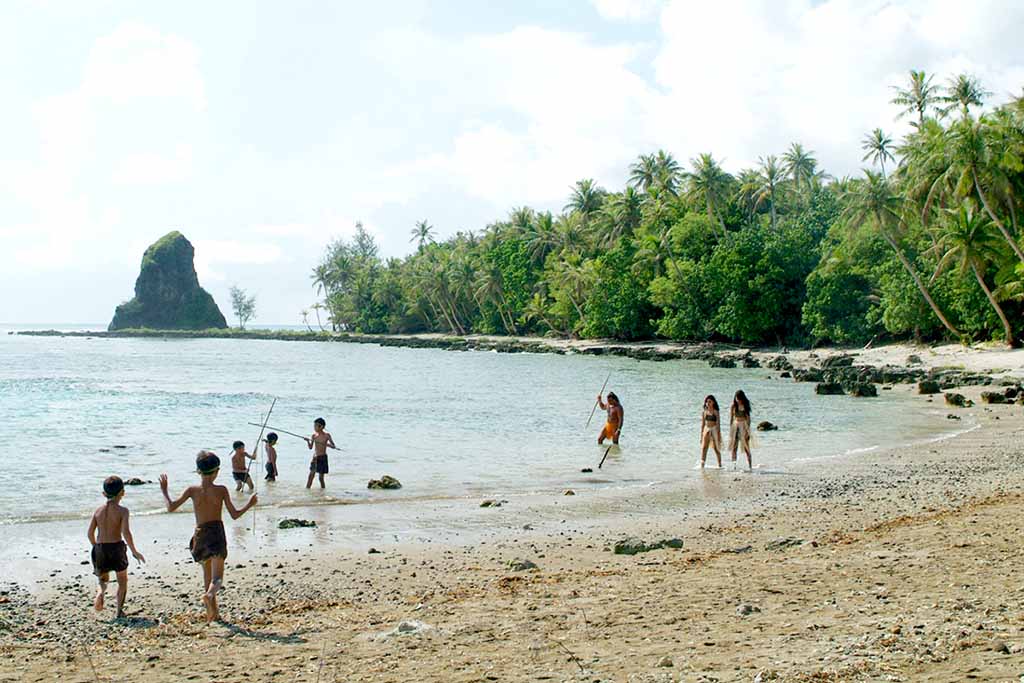Folktale: Puntan and Fu’una: Gods of Creation

Interpretive essay: CHamoru cultural values
Puntan and Fu’una are the Chamorro/CHamoru creation gods. Puntan, a male, and Fu’una, a female, are brother and sister. The account of their creation of the world constitutes one of the most important oral histories of the CHamoru people. Because the account has been passed along through oral tradition, there are varying versions of the story.
According to the CHamoru people, a very long time ago, Puntan and Fu’una devised a plan in which their supernatural forces would be put to extremely powerful use. Puntan instructed his sister to take apart his body and create the parts of the world. One of his eyes would become the sun, and the other would be transformed into the moon. Puntan’s eyebrows would become rainbows. His back would become the earth.
Fu’una had supernatural powers of her own. She used her energy and spirit to bring to life the parts of her brother’s body that now formed the world. With her power, she made the sun shine and the earth blossom. After she completed her task of bringing new life to Puntan’s body parts, Fu’una decided to create life out of her body, as she had her brother’s. She threw her body into the earth and created Fouha Rock, sometimes called Creation Point. Out of Fouha Rock, the first human beings emerged. This rock can be found close to Humåtak Bay in the southern part of Guam.
CHamoru account of creation
Almost every culture has its own account of creation, and each one tells a unique story. This account of the creation of the world tells us a lot about CHamoru culture. It tells us that the CHamoru people had their own religion for perhaps centuries before the introduction of Christianity.
Puntan and Fu’una are only two of the gods in the ancient CHamoru religion. Historical sources have all referred to the CHamorus as pagans and have denied the existence of a religion in the Mariana Islands. Thus, CHamoru gods such as Puntan and Fu’una have been referred to historically as “myths,” “legends,” or “superstitions.”
The Puntan and Fu’una account also tells us that in the CHamoru culture, men and women were both respected as powerful and contributing members of society. The CHamoru people had a matrilineal system in which gender roles were balanced equitably so that men and women shared power and responsibility.
In addition to the Puntan and Fu’una account, this gender balance can also be found in the political system. In CHamoru politics, the two most powerful titles in society were held by a male and a female, the maga’låhi (leading son) and the maga’håga (leading daughter).
Brothers and sisters
The titles maga’låhi and maga’håga demonstrate the cultural significance of brothers and sisters, and this highlights another important CHamoru cultural lesson that can be learned from the account of Puntan and Fu’una. The unique brother-sister relationship between the two gods reflects the matrilineal system that was practiced by the CHamoru people. In the matrilineal system, brothers and sisters relied strongly upon each other to protect family property, raise the children of the family, and generate assets to keep the family well endowed. The brother-sister relationship was considered absolutely permanent and completely reliable.
By contrast, the husband and wife relationship was considered impermanent, and thus husbands and wives were not expected to be eternally indebted to each other in the ways that brothers and sisters were.
The Puntan and Fu’una oral history, therefore, teaches not only a beautiful creation account, but also a story of CHamoru culture in terms of its religion, gender roles, and matrilineal system.
I Tinituhon
Featuring Rita Nauta and Andrew Artero
For further reading
Cunningham, Lawrence J. Ancient Chamorro Society. Honolulu: Bess Press, 1992.
Flood, Bo. Marianas Islands Legends: Myth and Magic. Honolulu: Bess Press, 2001.
I Ma Gobetna-na Guam: Governing Guam Before and After the Wars. The Hale’-ta Series. Hagåtña: Political Status Education Coordinating Commission, 1994.
Russell, Scott. Tiempon I Manmofo’na: Ancient Chamorro Culture and History of the Northern Mariana Islands. Saipan: Commonwealth of the Northern Mariana Islands Division of Historic Preservation, 1998.
Souder-Jaffery, Laura Marie Torres. Daughters of the Island: Contemporary Women Organizers of Guam. MARC Monograph Series 1. Mangilao: Micronesian Areas Research Center, University of Guam, 1987.